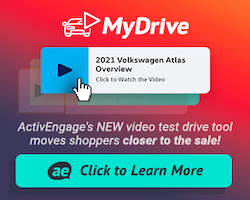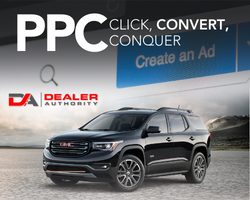As I wrote in 2015’s Self-Driving Cars: the Winners and the Losers, new car dealers will be among the “Obvious Losers” when, not if, self-driving vehicles become ubiquitous.
However, I also predicted that this evolution wouldn’t likely begin impacting new car dealers before 2025. My timeline has actually contracted a little in the last year and the objects in the mirror might be closer than they appear.
Let’s look at a few fast facts:
- Uber recently announced a pilot in Pittsburgh that will include 100 autonomous Volvos before year’s end. Read more – http://www.bloomberg.com/news/features/2016-08-18/uber-s-first-self-driving-fleet-arrives-in-pittsburgh-this-month-is06r7on
- A fleet of self-driving taxis has already been launched in Singapore. Read more – http://en.yibada.com/articles/154785/20160828/self-driving-cars-singapore-self-driving-taxis-free-ride.htm
- Google’s self-driving cars have amassed more than 1.8 million miles with just one minor fender-bender dubiously blamed on their cars. Read more – http://hothardware.com/news/google-self-driving-car-causes-its-first-accident
- Ford plans to leap frog over driver-assist to fully autonomous vehicles. Read more – http://www.bloomberg.com/news/articles/2016-08-16/ford-aims-to-offer-fully-autonomous-ride-sharing-vehicle-by-2021
Self-driving vehicles are here. They arrived sooner than most people thought; and they will eventually be extremely disruptive to the automotive retail model we know today.
The “when” they become extremely disruptive is the multi-billion-dollar question.
Of course, because there is likely to be little more than softening in new car volumes for next 2-3 years (short of some economic calamity), most dealers will continue to focus on this month, this weekend and today. Once the disruption becomes noticeable at the retail level, it will probably be too late for many dealers to make the bold cultural changes or broad strategic moves that will be required to stay on top for the long term.
Yeah, but what about…?
The autonomous vehicle naysayers all have lots of “feelings” and anecdotal evidence why it won’t happen… ever. I liken them to the proverbial buggy whip salesmen; those unenlightened souls whom we imagine must have similarly scoffed at Karl Benz over 100 years ago.
Let me give you some math – back-of-the-napkin style:
- 46 – The number of minutes each day the average American spends behind the wheel according to AAA. Read more – http://newsroom.aaa.com/2015/04/new-study-reveals-much-motorists-drive/
- 3.2% – 46 minutes divided by 1,440 – the number of minutes in a whole day.
- 96.8% – The percentage of each day American’s are not driving.
- 80% – The average cut that an Uber driver gets from every fare. Read more – http://www.idrivewithuber.com/how-much-do-uber-drivers-make/
- 12,600 – The number of people who won’t die in a vehicle crash in America every year, assuming a 100% autonomous fleet would reduce vehicle deaths by just 33% – most estimate this much higher. Read more – http://www.newsweek.com/2015-brought-biggest-us-traffic-death-increase-50-years-427759
- $186 Billion – The annual amount Americans spend on car insurance, because 90% of accidents are human-caused. Read more – http://www.nasdaq.com/article/a-look-at-the-personal-automobile-insurance-market-in-the-us-cm473879
So… A bunch of lives saved, billions not spent, cars not sitting idle 96% of the time… Hmm, seems like this thing is really gonna happen. Now what? What’s a new car dealer to do with this knowledge?
Relax. Breathe. I’m here to help. Here are just a few of the options that every new car dealer (including and especially the large groups) should be doing right now in advance of this disruption:
1. Focus on Used Cars
Turning your attention to used cars today will allow you to earn better margins immediately while you develop better processes for the future. In other words: Focus on used cars, but not like you do today.
Let me repeat: Focus on used cars, BUT NOT LIKE YOU DO TODAY.
Think Carvana, think Texas Direct Auto, think CARite.
If you’re an average new car dealer in America, buying a used car from you isn’t much fun. The process is too long; your team appears to be moving too slowly and anything you do that even feels askew will be seen as crooked by the average buyer.
You can either take offense to what I’ve written or you can begin to streamline everything in used cars from acquisition to reconditioning to pricing/merchandising to the sale. The details of this transition would fill a book, so seek out experts and begin to read everything you can from respected industry authorities.
Hint: they’re usually the ones not trying to sell you anything.
More than anything else, become dissatisfied with your used car team’s performance. This, more than any other trait, is what separates your 30 used cars a month from Texas Direct Auto’s estimated 2,500+.
This does not mean you beat your team up at every turn, but it does mean that you challenge them constantly. When they hit 35, you ask how and when will we hit 50? When they hit 50, you ask how and when will we hit 100?
Rinse, lather, repeat.
Why used? Because when, not if, many of us stop buying new cars for transportation (because we’re using an auto-Uber for nearly everything) there will still be millions of used vehicles on the road that will be traded, bought and sold. Only those dealers with the most efficient processes providing the best customer experiences will be around to take part in that market.
2. Focus on Service
Again, focus on this, but not like you do today. Because – and I say this with the upmost respect for your team – your service experience stinks!
So far this year I’ve had vehicles serviced by Safelite, Tire-Rama and my local Dodge dealer. Make no mistake, all three of these “made all the money,” but I would only recommend two of them to my family and friends (Hint: it ain’t the Dodge dealer).
So, focus on service, BUT NOT LIKE YOU DO TODAY.
Think Safelite and Tire-Rama. I’ve previously written about my experiences with Tire-Rama and will eventually get around to detailing my Safelite experience from this year, but let me take you through just a few of the highlights and see if this is the same experience your customers enjoy when they service with you:
- Intuitive, fast and easy online scheduler that gave me confidence that my order was correct and received. (Unless you’ve tried your online scheduler personally, you have no idea what your customers might be experiencing.)
- Immediate confirmation followed by a perfect series of both email and text communications from Safelite and the windshield installer. (I am always treated like I have three heads when I arrive for an appointment at my local new car dealer for service.)
- Clear instructions on everything I needed to do prior to their tech’s arrival and what I should expect during the installation. (Are you certain that you properly and accurately manage your customers’ expectations prior to and during service with you?)
- The tech was on-time, courteous, attentive and appropriately communicated with me throughout the installation. (Have you had to install a Service BDC just to have someone answer irate customer calls because your service advisors over-promise and under-deliver?)
- The tech thoroughly vacuumed my truck (including the bed) and even swept the area around it. (My vehicle wasn’t even run through the wash at the Dodge dealer during my last service; despite a $380+ customer-pay RO.)
This was a “WOW” experience for me; as I am sure it is for most of Safelite’s customers.
Fixed Operations is where you make your best margins, yet the experience is often so bad that dealers get only about 30% of the potential service visits; with the rest going to local shops and the chains. (More: http://www.autotrader.com/car-news/new-study-shows-car-dealerships-are-missing-service-business-opportunity-252066)
The answer for dealers that are in this for the long haul is simple: I need my team to “wow” our service customers so that they’ll gladly service with us every time.
Of course, this means you’ll need to become more like Safelite and Tire-Rama while employing their customer-first attitudes towards everything they do, and less like your team operates today (with its “how-can-I-maximize-my-pay-without-having-to-talk-to-too-many-pesky-customers-today” approach).
Why service? Because when, not if, many of us stop buying new cars for transportation, because we’re using an auto-Uber for nearly everything, there will still be millions of used vehicles on the road that will need to be serviced. Only those dealers with the most efficient processes providing the best customer experiences will be around to take part in that market.
3. Add Powersports Franchises
This is a simple one: Self-driving motorcycles, autonomous ATVs, automatic Sea-Doos, etc. will mean exactly zero fun. Use today’s profits to buy a powersports and/or boat franchise or two.
Of course, you won’t want to run these like an old-school dealership. The road-to-the-sale here can be a lot less stressful for consumers (and a lot more profitable for you) if you walk them through with a focus on transparency (price and process transparency) and customer experience. (After all, they’re not buying transportation, they’re buying recreation.)
4. Add Custom Shops
Fast forward ten years. (By the way, ten years is a lifetime when it comes to technology and money.) There will be plenty of holdouts who will still want to drive themselves to work or the airport, etc. The holdouts will primarily be made up of those very few who actually drive for the pleasure of driving, those who are afraid of autonomous technology, and those who continue to drive a used car.
For the vehicle enthusiast-types, they’ll want to keep their rods looking sharp. Having a service department that is known for great overall customization, exotic wheels and tires, audio options and custom paint will allow you to stand out from the oil change and muffler chains.
5. Invest in Autonomous Vehicles
This may only be a big group play – think Asbury, Berkshire, AutoNation, Penske. It’s important to stress that the ultimate winners with autonomous cars won’t be using traditional dealerships to service their vehicles. They will self-service, self-insure and likely build the vehicles themselves.
Moreover, the manufacturers of self-driving cars won’t be selling those vehicles they produce to fleet management companies; they will be partnering with or even managing the fleets themselves.
This is what makes the stock buybacks that many of the publicly-traded groups are participating in so frustrating for anyone looking to hold these stocks for the long term. Stock buybacks are short-term thinking that maximize share value for a few months and increase executive bonuses. Stock buybacks do nothing to ensure the long-term health and prosperity of these corporations.
Instead of using the cash accumulated from years of selling cars in an improving market to temporarily prop up the share price, the big groups should be looking for ways to prepare for the coming autonomous vehicle disruption. Whether this means investing in Uber-like companies or making sure they’re well-positioned to be known as the “used car sales and service leader” in their markets is up to their respective leaders.
6. Buy a Bar
While this is really a metaphor for making sure that dealers are properly diversified, the idea of buying a bar (or a chain of bars) is actually not a bad one given that once self-driving cars become ubiquitous, the quaint tradition of drinking in bars will be coming back strong.
The current barriers for most people to, say, watching Monday Night Football at a local pub are both the thought of a DUI and the cost and inconvenience of a traditional taxi. With a self-driving Uber, these barriers vanish.
Entertainment, nightlife, grabbing a beer after work, will all increase once the obstructions to these are removed – not to mention what will happen when those not in the automotive or insurance fields have additional discretionary income to spend.
Dealers who’ve not already done so would be smart to begin diversifying their holdings to industries that will not be dependent on Americans buying 17 million new cars a year. The disruption from the autonomous car is coming and anyone willing to open their eyes can see that. How you begin to prepare for this evolution is up to you.
Join the conversation over in the dealer forums.







